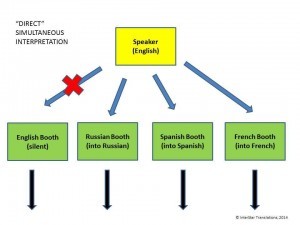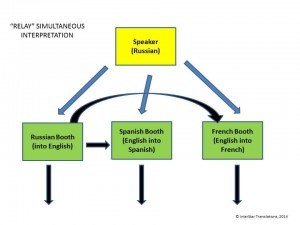There are two main ways to set up interpretation equipment: “direct” and “relay” simultaneous interpretation.  Both have their advantages and disadvantages, so clients need to have a basic understanding how these two ways work.
Both have their advantages and disadvantages, so clients need to have a basic understanding how these two ways work.
“Direct” Simultaneous Interpretation
“Direct” simultaneous interpretation is mostly used in the United Nations, other international organizations, or when not many languages are involved.
The equipment is set up as follows:

In this example, the presenter is speaking English on the podium. The English interpretation booth will, naturally, be silent and simultaneous interpretation will be conducted into all the other languages, in our example, into Russian, Spanish, and French.
“Relay” Simultaneous Interpretation
This type of simultaneous interpretation is used when all conference interpreters in each booth do not interpret from all the languages at a conference.
For example, we may have interpreters in the French booth who interpreter only from English and Spanish into French. If the speaker on the podium speaks Russian, the Russian interpreters become what is called “pivot” i.e. they interpret the speech from Russian into English (or any other agreed upon “pivot language”) and the French booth is doing their interpretation from the English interpretation it is receiving from the Russian booth.

This mode of interpretation is convenient, if there is a conference with many languages, because we may not be able to put into each booth more than 2 or 3 people.
Both these modes of interpretation have their advantages and disadvantages.
“Direct” interpretation involves only one intermediate stage between the speaker and the listener. It is, by all means, better, however, it may not be possible to staff all the booths with all the conference interpreters working from all conference languages.
Moreover, if the presentations are mostly made in one language, for example, English, the English booth will mostly be silent.
“Relay” interpretation places a lot of additional responsibility on the pivot interpreter. He or she needs to be aware that it is not only the delegates, but other interpreters as well, who listen to the interpretation and interpret into their respective languages. Any glitch may be repeated by other booths.
However, relay simultaneous interpretation is quite possible and – in the overwhelming majority of cases when expert conference simultaneous interpreters are hired – is quite successful.
Moreover, any respectable course in conference interpretation must include training in relay interpretation to prepare future conference interpreters to the additional challenges of relay.
A specific required setup and how it may need to be customized should be discussed with your simultaneous interpretation company as early as possible.

